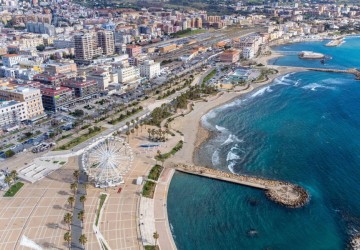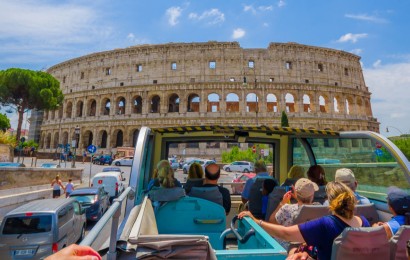If you want to discover the best things to do in Civitavecchia this guide can help you.
Civitavecchia is a city that boasts a very ancient history. The city was created by an Etruscan settlement and took on considerable importance thanks to the presence of the port, which is currently one of the most important in Italy.
What are the best things to do in Civitavecchia?
Here are the 10 best things to do in Civitavecchia during your trip:
- Port of Civitavecchia
The port of Civitavecchia is one of the most important and busiest ports in Italy, located in the Lazio region. It is an important hub for international shipping and a popular destination for cruise ships.
It has been in use since ancient Roman times and has grown to become one of the busiest ports in Europe today. Thanks to its strategic position it assumes a role of primary importance for the network of Rome and other areas of Italy. - Forte Michelangelo
The Forte Michelangelo is a 16th-century fortress built to protect the port of Civitavecchia from naval attacks and pirates. The Fort is a remarkable example of Renaissance architecture and military engineering, with powerful ramparts and high walls.
Visitors to this historic site can explore its imposing ramparts, towers and courtyards and admire its spectacular sea views. Michelangelo Fortress is an important part of Italian history not to be missed!
→ Do not miss our Civitavecchia Guide to discover its history and its traditions. - Piazza della Vita
Piazza della Vita is a lively square that has been the center of city life for centuries.
The square offers visitors breathtaking views of the Mediterranean Sea and is home to a variety of restaurants, cafes, shops and other businesses that attract both locals and tourists. It also hosts several festivals throughout the year, making it an ideal place to experience the culture and history of Civitavecchia.
If you are looking for a place to enjoy a dinner with friends or listen to some live music. - Terme Taurine
The Terme Taurine, also known as Terme di Traiano, constitute an important archaeological site and one of the most important thermal complexes of the Roman age.
The name comes from the Latin term taurus, from the name of an ancient bull which, according to an ancient tradition, caused gushes of hot sulphurous water to arise by scrabbling in the ground. The first to exploit its waters were the Etruscans, who built rudimentary baths, which in turn were developed and expanded only in Roman times. The spa area was considerably frequented throughout the imperial age until the decline of the empire. Subsequently, the complex was completely abandoned.
Today, the water no longer flows in the Terme Taurine archaeological park, but if you want to appreciate the therapeutic properties of its warm waters, we recommend that you visit the nearby Ficoncella spa complex. - National Archaeological Museum of Civitavecchia
The National Archaeological Museum of Civitavecchia houses a vast collection of archaeological finds from the Roman period, as well as other civilizations and cultures throughout history.
Visitors can explore the history and culture of ancient Rome through artifacts such as coins, ceramics, sculptures and more.
The museum also offers educational programs for children to learn about the history of Rome in an interactive way. - Cathedral of Saint Francis of Assisi
The Cathedral of Saint Francis of Assisi in Civitavecchia is a splendid example of Gothic architecture located in the city of Civitavecchia and is the seat of the episcopal chair of the diocese of Civitavecchia-Tarquinia.
Built on the remains of a small Franciscan church built under the pontificate of Paul V, this cathedral has a high baroque facade. Above the tympanum the church is adorned with two large statues representing St. Francis of Assisi and St. Anthony of Padua. - Terme della Ficoncella
The Terme della Ficoncella are very ancient baths that were used as an alternative to the Baths of Trajan. The therapeutic properties of the thermal baths are countless, indicated in the treatment of various skin diseases. Respiratory and intestinal. A curiosity: Their name derives from the presence of fig trees among the tanks.
If you are looking for a day of relaxation and well-being, this structure is the right one for you. In fact, these spas are a real hidden treasure, and during the summer the spas remain open until 2 am to enjoy a starry sky and the gentle sea breeze. - Civitavecchia Market
To fully know a city you must also know its gastronomic culture. In the heart of the historic center you will find the Civitavecchia Market, also known as San Lorenzo Market where you can buy fresh food such as fruits and vegetables and gastronomic specialties of the territory.
Famous also its historic fish market born in a masonry structure dating back to 1904. - Pineta della Frasca
The Pineta della Frasca is a natural coastal area recently established as a national monument in which there is an important archaeological and landscape area, the ancient port of Columna and a Roman port settlement.
In the hinterland there is also a beautiful pine forest, ideal for shelter from the heat of summer and to organize a pleasant picnic. - Try the local culinary specialties
Enrich your trip by trying the typical dishes of the territory. In Civitavecchia you can find many places by the sea where you can taste the famous fish soup civitavecchiese, stuffed squid, meatballs affogati alla Civitavecchiese and lumachette with sauce. If you want to be street-food lovers, you should definitely try the covered pizza civitavecchiese, a real treat!
Discover Civitavecchia in a unique way with our Panoramic Hop-on Hop-off Bus Tour!

